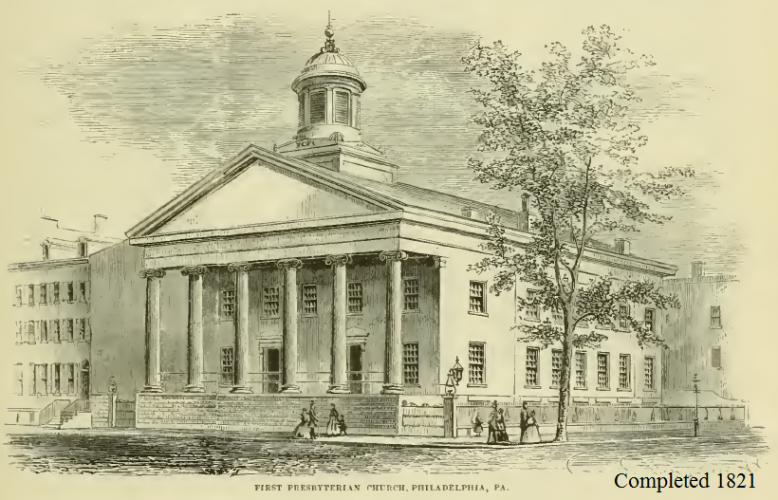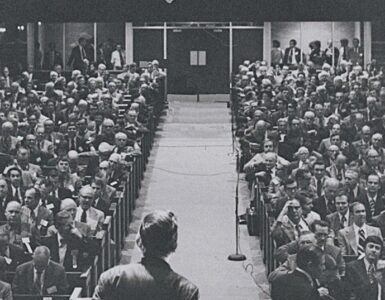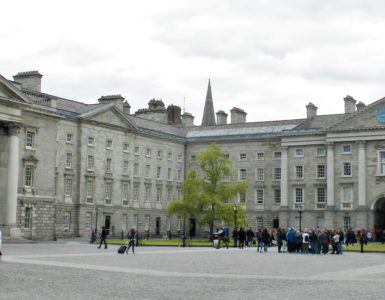When the Second General Assembly of the Presbyterian Church in the United States of America (PCUSA) convened in First Church, Philadelphia, May 20, 1790, the retiring moderator, John Rodgers, delivered his sermon from Acts 11:24, “For he was a good man,” speaking of Barnabas, “and full of the Holy Ghost and of faith: and much people was added unto the Lord” (KJV). Rodgers was a father of the church ministering in New York City where he continued until his death in 1811. The minister elected to moderate the second general assembly was another father of the church, Robert Smith. The two were close friends and had some similarities in their backgrounds. Both studied in Samuel Blair’s academy in Chester County Pennsylvania; both were converted through the preaching of the itinerant evangelist, George Whitefield; both served on the committee to compose the PCUSA constitution published in 1789; and both were members of the board of trustees for the College of New Jersey, currently Princeton University.
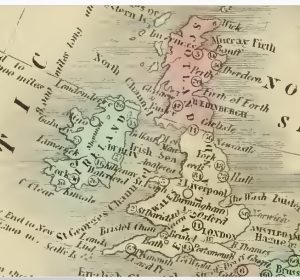 Robert Smith was born in Londonderry, Ireland, in 1723. His family had moved there from Scotland but then relocated to the American colonies when Robert was about seven years of age. His ancestors on both his father’s and mother’s sides had farmed for several generations. Arriving in America the Smith family settled along the Brandywine about forty miles from Philadelphia. At the age of fifteen, Robert believed the gospel through the preaching ministry of George Whitefield during his first evangelistic trip to America. Within a short time of his conversion, Robert believed he was called to the ministry. His parents supported the decision and encouraged him to pursue studies in the school operated by Pastor Samuel Blair in Chester County, Pennsylvania. Blair’s curriculum was designed primarily to prepare men for the ministry. Robert was a good student who quickly acquired the classical languages and absorbed theological subjects.
Robert Smith was born in Londonderry, Ireland, in 1723. His family had moved there from Scotland but then relocated to the American colonies when Robert was about seven years of age. His ancestors on both his father’s and mother’s sides had farmed for several generations. Arriving in America the Smith family settled along the Brandywine about forty miles from Philadelphia. At the age of fifteen, Robert believed the gospel through the preaching ministry of George Whitefield during his first evangelistic trip to America. Within a short time of his conversion, Robert believed he was called to the ministry. His parents supported the decision and encouraged him to pursue studies in the school operated by Pastor Samuel Blair in Chester County, Pennsylvania. Blair’s curriculum was designed primarily to prepare men for the ministry. Robert was a good student who quickly acquired the classical languages and absorbed theological subjects.
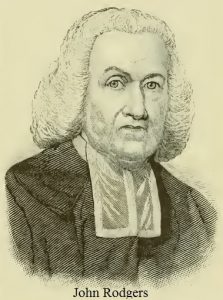 Once he completed studies with Rev. Blair, Robert Smith sought licensure and ordination by his presbytery. On December 27, 1749, he was licensed to preach by the Presbytery of Newcastle, New Side. Following less than a year testing his gifts, he accepted a double call to the churches in Pequea and Leacock, Pennsylvania, on the ninth of October, 1750. He was ordained and installed the pastor of the two congregations on March 25, 1751. Robert’s friend, John Rodgers, was the moderator of presbytery for Smith’s ordination.
Once he completed studies with Rev. Blair, Robert Smith sought licensure and ordination by his presbytery. On December 27, 1749, he was licensed to preach by the Presbytery of Newcastle, New Side. Following less than a year testing his gifts, he accepted a double call to the churches in Pequea and Leacock, Pennsylvania, on the ninth of October, 1750. He was ordained and installed the pastor of the two congregations on March 25, 1751. Robert’s friend, John Rodgers, was the moderator of presbytery for Smith’s ordination.
It was quite common for ministers to establish academies in conjunction with their pastoral duties and young Smith shortly established a school with its curriculum designed primarily to teach Latin, Greek, and Hebrew. It became necessary to hire additional teachers because the student body had increased through the enrollment of students from all over Pennsylvania and Maryland. At the time, there was not an established seminary program to prepare men for the ministry, so Smith’s former students often returned to him for theological instruction.
Currently, it is often written in a pastoral call to a prospective minister that one of the goals of the financial compensation promised is that the amount is sufficient for the minister “to be free from worldly cares.” The minister is paid so he can pray for his sheep rather than having to pray for wisdom as to how to make too few funds pay too many bills. The trouble is that many congregations of the past were in farming communities where it was not uncommon for ministers to suffer extended periods without income because the members’ depended on harvesting crops nourished by the Lord’s bringing the rain to fall on the just and unjust. Sometimes the rain did not come, there was disease, or insect infestations. Thus, Robert Smith’s academy was not only a service to families in an era of limited educational opportunities but also a way for him to supplement his meager income. The financial situation was difficult because in 1759 he was released from his call to the Leacock Church and then later asked to resign from the Pequea Church because of his financial shortage, but Rev. Smith withdrew his resignation when the Pequea Church resolved the difficulty and he continued there until his death on April 15, 1793, in the seventy-first year of his age. He was returning home from a meeting of the Board of Trustees of the College of New Jersey when he stopped at a friend’s house because he did not feel well and passed away.
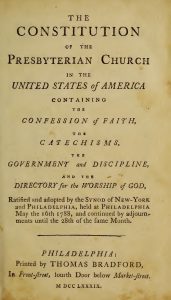 Robert Smith was a faithful and often honored churchman. In 1760, he received the Doctor of Divinity from the College of New Jersey. It was in 1772, when he was appointed a trustee of the College of New Jersey and he served the school for the rest of his life. As has been mentioned, he was the second Moderator of the General Assembly, and he helped compose the Presbyterian constitution published in 1789. Due to the extent of influence upon successive generations of ministers from his academy and divinity instruction, he was often asked by his former students to preach in both large and small churches. He did not discriminate against smaller churches for more prominent pulpits but instead enjoyed supplying small churches to encourage and counsel them as he could.
Robert Smith was a faithful and often honored churchman. In 1760, he received the Doctor of Divinity from the College of New Jersey. It was in 1772, when he was appointed a trustee of the College of New Jersey and he served the school for the rest of his life. As has been mentioned, he was the second Moderator of the General Assembly, and he helped compose the Presbyterian constitution published in 1789. Due to the extent of influence upon successive generations of ministers from his academy and divinity instruction, he was often asked by his former students to preach in both large and small churches. He did not discriminate against smaller churches for more prominent pulpits but instead enjoyed supplying small churches to encourage and counsel them as he could.
Dr. Smith was married twice. His first wife, Elizabeth, was the sister of his Chester County mentor and friend, Samuel Blair. They were married May 22, 1750, and they enjoyed the births of seven children. Two of the children died in their early years, two became physicians, and the remaining three, Samuel Stanhope, John Blair, and William Richmond became ministers. Samuel would go on to succeed John Witherspoon in the presidency of the College of New Jersey; John Blair would pastor and briefly serve Hampden-Sydney College as its president; and William would be a shepherd in the Presbyterian Church for several years before changing denominations to serve a Reformed Dutch Church in New Jersey. Elizabeth died at some point and Robert remarried in 1779. His second wife was Sarah who was the widow of Rev. William Ramsey of Fairfield, New Jersey. Robert and Sarah had one child, a daughter, born in 1780.
 Robert Smith’s publications were primarily sermons, but he did publish one book in 1757 to address a conflict within New Castle Presbytery involving Old Side-New Side issues. It was printed in Lancaster by W. Dunlap with the title, The Detection Detected: Or a Vindication of the Revd. Mr. Delap, and New-Castle Presbytery, from the Charges of Injurious Reasonings … [etc.]. When the Second Presbytery of New Castle convened at White Clay Creek, January 2, 1759, he delivered a sermon on Ezekiel 1:16 titled, A Wheel in the Middle of a Wheel, or the Harmony and Connection of the Various Acts of Divine Providence, which was published in a pamphlet later that year. In 1772, his sermon on Isaiah 40:11 was issued bearing the title, The Bruised Reed Bound Up, and the Smoking Flax Inflamed; Or, The Weak Oppressed Believer Victorious through the Tender Care and Grace of Christ…[etc.]. Included in The American Preacher, Vol. 4, 1793, are his three sermons on faith titled, “The Nature of Saving Faith,” “The Excellency of Saving Faith,” and “Practical Uses from the Nature and Excellency of Saving Faith.” Then in 1855 the Presbyterian Board of Publication distributed a collection of sermons titled, Sermons and Essays by the Tennents and Their Contemporaries, which included two sermons of Dr. Smith’s originally delivered in 1767 with the titles, “The Principle of Sin and Holiness,” and “The Spiritual Conflict.” On December 13, 1781, shortly after Gen. Cornwallis surrendered at Yorktown, Smith delivered two sermons of thanksgiving for God’s providence in directing the events of the war and bringing victory. The publication was titled, The Obligations of the Confederate States of North America to Praise God, Two Sermons Preached at Pequea, December 13th, 1781…[etc.]. Even though he did not write often, these few publications show pastoral, political, and denominational interests.
Robert Smith’s publications were primarily sermons, but he did publish one book in 1757 to address a conflict within New Castle Presbytery involving Old Side-New Side issues. It was printed in Lancaster by W. Dunlap with the title, The Detection Detected: Or a Vindication of the Revd. Mr. Delap, and New-Castle Presbytery, from the Charges of Injurious Reasonings … [etc.]. When the Second Presbytery of New Castle convened at White Clay Creek, January 2, 1759, he delivered a sermon on Ezekiel 1:16 titled, A Wheel in the Middle of a Wheel, or the Harmony and Connection of the Various Acts of Divine Providence, which was published in a pamphlet later that year. In 1772, his sermon on Isaiah 40:11 was issued bearing the title, The Bruised Reed Bound Up, and the Smoking Flax Inflamed; Or, The Weak Oppressed Believer Victorious through the Tender Care and Grace of Christ…[etc.]. Included in The American Preacher, Vol. 4, 1793, are his three sermons on faith titled, “The Nature of Saving Faith,” “The Excellency of Saving Faith,” and “Practical Uses from the Nature and Excellency of Saving Faith.” Then in 1855 the Presbyterian Board of Publication distributed a collection of sermons titled, Sermons and Essays by the Tennents and Their Contemporaries, which included two sermons of Dr. Smith’s originally delivered in 1767 with the titles, “The Principle of Sin and Holiness,” and “The Spiritual Conflict.” On December 13, 1781, shortly after Gen. Cornwallis surrendered at Yorktown, Smith delivered two sermons of thanksgiving for God’s providence in directing the events of the war and bringing victory. The publication was titled, The Obligations of the Confederate States of North America to Praise God, Two Sermons Preached at Pequea, December 13th, 1781…[etc.]. Even though he did not write often, these few publications show pastoral, political, and denominational interests.
BARRY WAUGH
Notes—Unfortunately, a picture of Robert Smith was not located. The picture of First Church, Philadelphia, shows the second building used by the congregation after the building used for the General Assembly in 1790. It was mentioned in the bibliographic paragraph that Dr. Smith preached a sermon at the meeting of the “Second Presbytery of New Castle” in January 1859. The Synod of New York and Philadelphia in May of the same year moved to have the First and Second Presbyteries of New Castle united into one presbytery as part of the reunification of the Old Side and New Side (Klett, Minutes of the Presbyterian Church in America, 1706-1788, p. 348). A helpful general reference for Presbyterian and Reformed history is Dictionary of the Presbyterian & Reformed Tradition in America, InterVarsity Press, 1999, D. G. Hart, editor, and Mark A. Noll, consulting editor, which contains articles by A. C. Guelzo on the New Side-Old Side division of the Presbyterians.
Sources include L. J. Trinterud’s A Bibliography of American Presbyterianism During the Colonial Period, Philadelphia: Presbyterian Historical Society, 1968. Much of the information in this biography was located in W. B. Sprague’s Annals of the American Pulpit, volume 3, 1858, but other information was gleaned from standard Presbyterian reference works. The pictures of John Rodgers and of First Church, Philadelphia, are from Nevin’s Encyclopedia of the Presbyterian Church, 1884.


